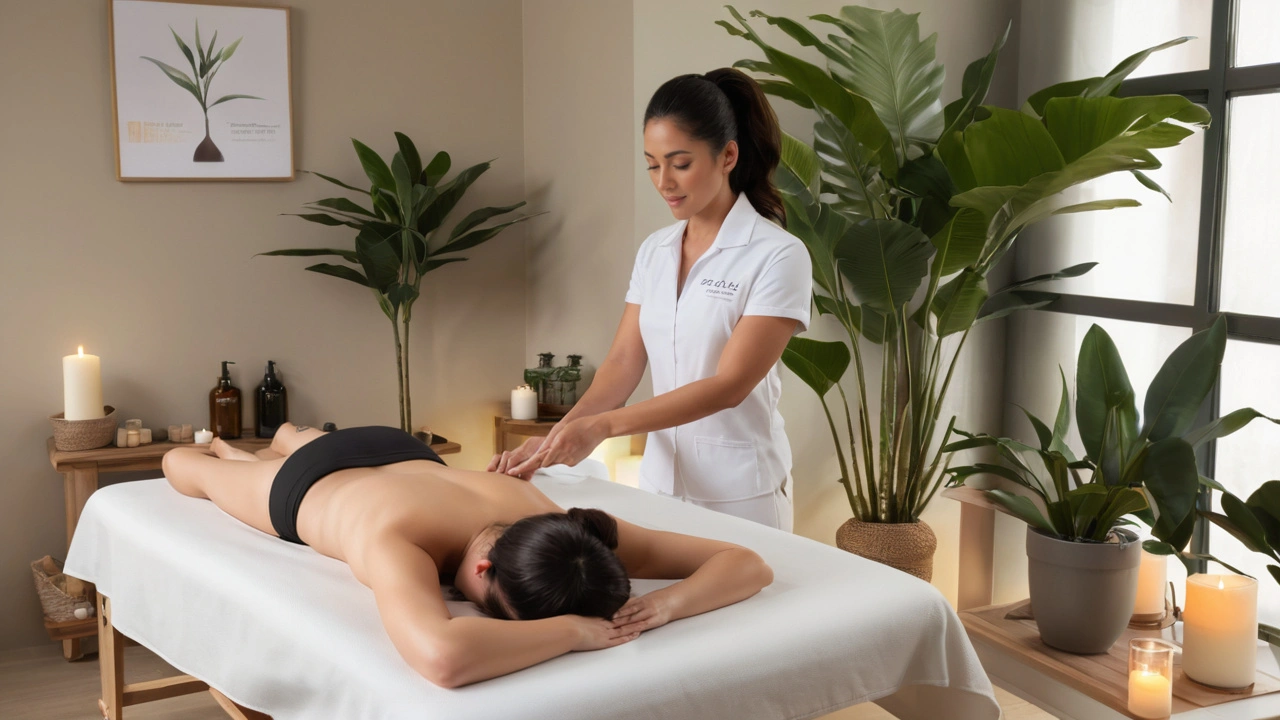Do you often find yourself dealing with muscle pain or stress? If so, Trigger Point Massage Therapy might be the answer. This powerful technique targets specific areas in your muscles, known as trigger points, which could be the source of much of your discomfort. By applying focused pressure, you can release these knots and experience relief.
But what exactly are trigger points? They are sensitive spots in your muscles that can cause pain and tension throughout your body. When these points are irritated, they can affect your overall wellbeing. Understanding them is the first step to addressing the issue.
Trigger Point Massage involves various techniques to alleviate muscle pain. From deep tissue massage to more gentle methods, there is a range of options to explore. The benefits extend beyond just pain relief; it can also reduce stress, improve circulation, and enhance your overall health.
Incorporating Trigger Point Therapy into your routine can be straightforward. You can learn some self-care techniques to use at home or seek professional help for a more thorough approach. It's all about finding what works best for you and making it a regular part of your self-care regimen.
Remember, taking care of your muscles is crucial for maintaining good health. Whether you decide to try self-massage or visit a professional therapist, these tips will help you on your journey to feeling better. Explore the world of Trigger Point Massage Therapy and discover how it can transform your life.
- Understanding Trigger Points
- Techniques and Benefits of Trigger Point Massage
- Incorporating Trigger Point Therapy into Your Life
- Tips for Self-Care and Professional Help
Understanding Trigger Points
Have you ever felt a knot in your muscle that just wouldn't seem to go away? That knot might be a trigger point. Trigger points are hyper-irritable spots located in a tight band of muscle fibers. These points can cause pain not just locally but also refer pain to other parts of your body, a phenomenon known as referred pain. It's as if your muscle is sending out an SOS, and the response is felt somewhere else entirely.
The concept of trigger points isn't new. Dr. Janet Travell, known for her work with U.S. Presidents John F. Kennedy and Lyndon B. Johnson, was a pioneer in this field. She described trigger points as “a highly localized, hyper-sensitive spot in a palpable taut band of skeletal muscle fibers.” Her research has been instrumental in understanding and treating muscle pain.
“Trigger points may cause motor dysfunction, such as weakness, muscle stiffness, and restricted range of motion.”—Dr. Janet Travell
So why do these tiny knots cause so much trouble? When a muscle is overused or injured, its fibers can get stuck in a contracted state. This leads to reduced blood flow, waste accumulation, and increased sensitivity in the affected area. Essentially, your muscle isn't able to relax or heal properly, and the resulting tightness and inflammation can create those painful knots we call trigger points.
Trigger points can develop due to various reasons such as poor posture, repetitive strain, or even stress. For instance, sitting at a desk all day without proper back support can lead to trigger points in your neck and shoulders. Athletes often develop them due to overtraining. Stress and emotional strain can also contribute, as they often cause us to tense up and hold muscles in a contracted state.
Diagnosing trigger points can be a bit tricky. Unlike other medical conditions, there are no blood tests or imaging studies that can confirm their presence. Instead, healthcare providers rely on physical examination and patient history to identify them. They may feel for tender spots and assess the surrounding muscle tension to pinpoint these problematic areas.
Interestingly, trigger points aren't just limited to your muscles. They can also affect your fascia, the connective tissue that surrounds your muscles. Myofascial pain syndrome is a related condition where these trigger points create widespread pain and discomfort, affecting not just localized areas but your entire body.
Understanding trigger points is crucial in treating them effectively. Knowing what they are, why they develop, and how to identify them empowers you to take better care of your muscles. Whether you're an office worker, an athlete, or someone dealing with chronic pain, recognizing these hidden troublemakers can be the first step towards relief.

Techniques and Benefits of Trigger Point Massage
Trigger Point Massage is a powerful tool for relieving muscle pain and tension. This form of therapy targets specific areas known as trigger points, where muscle fibers have become tight and knotted. By applying pressure to these areas, the knots can be released, improving muscle function and reducing pain. This is incredibly effective for those who deal with chronic muscle pain or tension headaches.
There are various techniques used in Trigger Point Massage. One common method is known as static compression, where sustained pressure is applied directly to the trigger point. The therapist may use their fingers, knuckles, or even special tools to apply this pressure. Another technique is known as stretching, where the muscle is gently stretched while pressure is applied. This combination of pressure and stretch helps to break up the knots and restore normal muscle function.
One interesting fact about trigger points is that they can cause pain in areas of the body far removed from the point itself. This phenomenon is known as referred pain. For example, a trigger point in the neck could cause pain in the head or even lead to tension headaches. Treating these points can often relieve pain that seems unrelated to the muscle being worked on.
Trigger Point Massage isn't just about pain relief; it's also about improving overall muscle health. By regularly working on trigger points, individuals can improve blood flow to the treated area. Increased blood circulation helps deliver oxygen and nutrients to the muscles, promoting faster healing and recovery. This benefit is particularly valuable for athletes or individuals who engage in regular physical activity.
For those who find it challenging to visit a therapist regularly, self-massage techniques can be highly effective. Using tools like massage balls or foam rollers, individuals can apply pressure to their own trigger points. This can be particularly useful for targeting hard-to-reach areas like the back or shoulders. Learning to identify and treat your own trigger points can be empowering and a great way to manage pain between professional sessions.
“Trigger point therapy is one of the fastest ways to relieve pain in herniated disc. It releases the pressure on the disc and breaks the pain cycle.” – Dr. Janet Travell
Another key benefit of Trigger Point Massage is stress reduction. The gentle, repetitive pressure and release can have a highly relaxing effect on the nervous system. This relaxation can help to decrease levels of cortisol, the body's main stress hormone, and promote a sense of calm. For people who experience stress-related muscle tension, this benefit alone can be transformative.
Trigger Point Massage is especially effective when combined with other therapies like physical therapy or chiropractic care. By addressing the muscle component of pain, it can enhance the effectiveness of other treatments. For example, chiropractors often find that adjusting a spine is easier and more effective when the surrounding muscles are relaxed and free of trigger points.
Many studies have backed up the benefits of Trigger Point Massage. One study published in the Journal of Bodywork and Movement Therapies found that patients who received Trigger Point Massage showed significant improvements in pain levels and range of motion compared to those who did not. The scientific community continues to explore the various ways in which this type of therapy can improve physical health, making it a well-respected component of modern muscle therapy.
In summary, Trigger Point Massage is a multifaceted approach to muscle health. It addresses pain at its source, improves circulation, reduces stress, and can be performed both professionally and at home. Its effectiveness is supported by both scientific research and the experiences of countless individuals who have found relief through this powerful therapy.

Incorporating Trigger Point Therapy into Your Life
Making Trigger Point Therapy a part of your daily routine can seem overwhelming at first, but it can be quite simple with a bit of guidance. Start by understanding that you don't need to tackle all your muscle knots at once. Small steps will lead to significant improvements over time.
One useful way to begin is by identifying the areas in your body where you often feel tension or pain. For many, this might be the shoulders, neck, or lower back. Once you’ve pinpointed these areas, you can use tools such as foam rollers or massage balls to apply pressure. Consistency is the key to success here. Spending just 10 to 15 minutes a day on self-massage can make a world of difference.
Utilizing resources like online tutorials or books on Trigger Point Therapy can also be beneficial. These resources provide a wealth of information on techniques and points to focus on, so you’re not navigating this journey alone. It’s also important to listen to your body and not push too hard. Gentle and consistent pressure will yield better results than aggressive techniques.
According to Dr. Janet Travell, a pioneer in the field of pain management, “Trigger points are a common cause of pain and discomfort that can be alleviated with intentional therapy and care.”
Incorporating Trigger Point Therapy doesn’t necessarily mean you have to do it all by yourself. Professional massage therapists are trained to identify and treat trigger points effectively. Scheduling regular sessions with a therapist can provide deeper relief and reinforce your self-care efforts. Look for therapists who specialize in myofascial release or deep tissue massage.
Setting aside time for Trigger Point Therapy is a commitment to your overall health and well-being. If you have a busy schedule, try incorporating it into your existing routines. For instance, you can do self-massage while watching TV or right before bed as a way to wind down. The flexibility of this therapy makes it easy to integrate into various aspects of your life.
Another way to enhance your Trigger Point Therapy experience is by combining it with other relaxation techniques like deep breathing, yoga, or meditation. These practices not only complement each other but also enhance the therapeutic benefits. Relaxing your mind and body can help alleviate muscle tension more effectively, creating a holistic approach to wellness.
Remember that the goal is to enhance your well-being, so it’s essential to stay patient and persistent. Muscle pain and tension didn’t develop overnight, and they won’t disappear overnight either. Consistent effort and dedication to self-care will bring about gradual yet significant improvements.
Here are a few practical steps to get you started:
- Identify common areas of pain and tension.
- Use tools like foam rollers, massage balls, or even your hands to apply pressure.
- Follow online tutorials or reference books for guidance.
- Incorporate therapy into your daily or weekly routine.
- Consider professional help if self-massage isn’t enough.
- Combine with other relaxation techniques for enhanced benefits.
By incorporating Trigger Point Therapy into your daily life, you’re taking proactive steps to address pain and improve overall well-being. A little effort can lead to significant, lasting changes.

Tips for Self-Care and Professional Help
When it comes to incorporating Trigger Point Massage Therapy into your life, self-care techniques and seeking professional help play crucial roles. Let's dive into some practical tips and methods to make the most of this therapeutic approach.
A great starting point for self-care is learning to locate and manage your own trigger points. You can begin by identifying areas that feel tender, tight, or painful. Common spots include the neck, shoulders, and back. Using your fingers or a massage tool, apply gentle, sustained pressure to these areas. Hold the pressure for about 30 seconds to a minute, and then slowly release. This can help break down the muscle knots and alleviate pain.
Consistency is key when it comes to self-massage. Setting aside a few minutes each day to work on your trigger points can lead to significant improvements. Additionally, integrating stretching exercises into your routine can help maintain muscle flexibility and prevent the formation of new knots. Yoga and Pilates are excellent options for stretching and strengthening your muscles.
Maintaining proper posture is another critical aspect of self-care. Poor posture can contribute to the development of trigger points. Be mindful of your posture throughout the day, whether you're sitting at a desk, driving, or standing. Ergonomic adjustments to your workspace and investing in supportive furniture can make a big difference.
While self-care is valuable, there are times when professional help is necessary. A certified massage therapist who specializes in Trigger Point Therapy can provide a more thorough and expert approach to addressing your muscle issues. They have the skills to identify and treat deeper and more stubborn trigger points that might be challenging to manage on your own.
Professional therapists often combine Trigger Point Massage with other techniques, such as heat therapy or stretching, to enhance the effectiveness of the treatment. This comprehensive approach can lead to faster and more lasting results. It's worth noting that regular sessions with a skilled therapist can serve as both a treatment and preventative measure, keeping your muscles in optimal condition.
When choosing a therapist, seek out someone with proper certification and experience in Trigger Point Therapy. Personal recommendations and online reviews can be helpful in finding the right professional. During your first session, communicate your specific issues and goals to ensure a tailored and effective treatment plan.
Dr. Janet Travell, a pioneer in the field of Trigger Point Therapy, once stated, "The way to health is to have an aromatic bath and a scented massage every day." While daily professional massages may not be practical for everyone, incorporating trigger point self-care and periodic professional sessions can bring you closer to that ideal.
In summary, combining self-care techniques with professional help can provide the most effective approach to managing and preventing trigger points. By staying proactive and making these practices a part of your routine, you'll be well on your way to enjoying a life with less pain and stress. Remember, your muscles work hard for you every day; showing them a little care and attention can go a long way.


 Health and Wellness
Health and Wellness